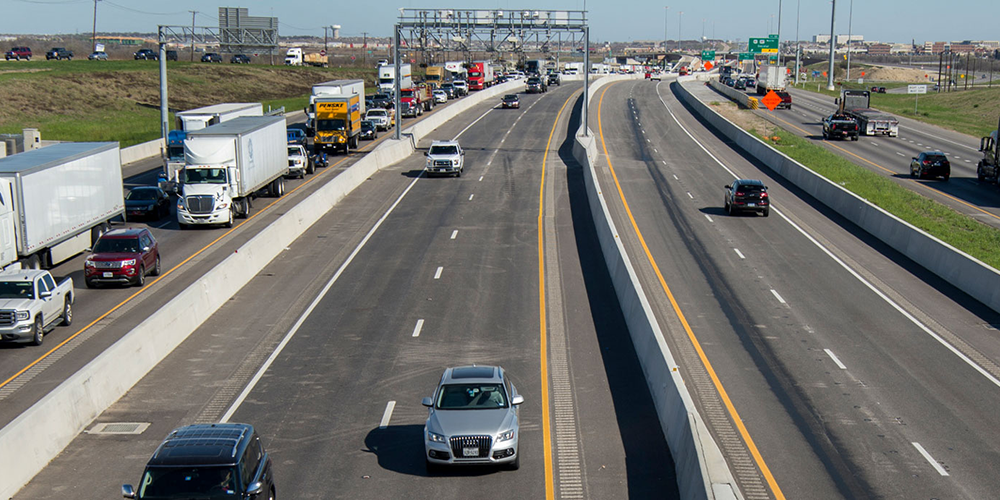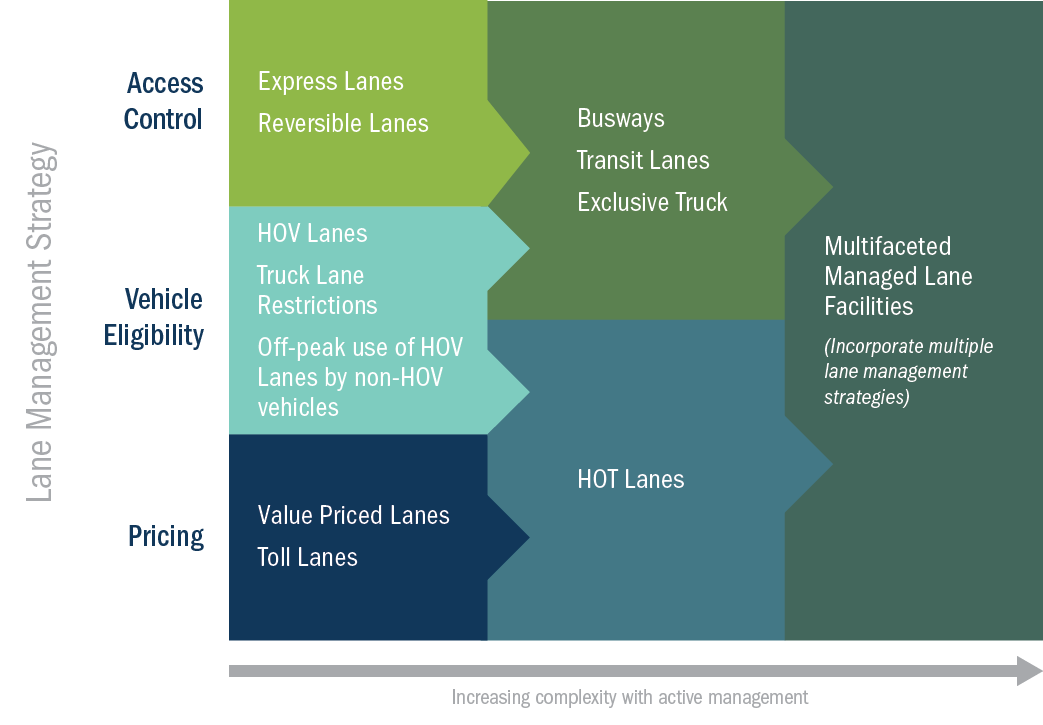Managed lanes
Express, toll, and HOV Lanes

What are managed lanes?
According to the Federal Highway Administration, managed lanes are highway lanes where operational strategies are proactively implemented and managed in response to changing conditions.
The diagram below captures the potential lane management applications that fall under the broad definition of “managed lanes.” On the left of the diagram are the applications of a single operational strategy. As you move to the right on the diagram, you get into more complex managed lane facilities that blend more than one of the strategies.

What are the different types of managed lanes?
Managed lane strategies fall into three main categories:
- Access control – Express lanes, reversible lanes.
- Vehicle eligibility – High-occupancy vehicle (HOV) lanes, truck lane restrictions, off-peak use of HOV lanes by non-HOV vehicles.
- Pricing – Value-priced lanes, toll lanes.
Are managed lanes toll roads?
There is a growing assumption that any form of a managed lane is synonymous with a tolling operation. While this is sometimes true, it is not a given. Lane management encompasses a wide variety of strategies, including but not limited to:
- High-occupancy vehicle (HOV) lanes.
- Express lanes (through-traffic lanes with fewer exits).
- Restricted lanes (e.g., trucks or buses only).
- Reversible lanes.
Alone or combined, all of these lane types are under the umbrella of a comprehensive managed lane strategy.

Definitions
- Dynamic pricing – fee adjusts in real-time to mitigate congestion in the lane.
- Exclusive truck lanes – lanes that declare whether no trucks or only trucks are allowed.
- Express lane – lane for through traffic, with fewer exits.
- High-occupancy tolled lane (HOT) – high-occupancy vehicles travel free or at discounted rates depending on demand; other vehicles pay a fee.
- High-occupancy vehicle lane (HOV) – access restricted to high-occupancy vehicles.
- Lane or time-of-day restrictions – allow access to managed lanes only at certain times of day or to certain vehicle types (e.g., trucks).
- Multifaceted managed lane facilities – incorporate multiple lane management strategies.
- Reversible lane – lane where traffic direction can be altered in response to conditions.
- Time-of-day pricing – fees increase or decrease at certain times of day.
- Transit lanes – dedicated lanes and rights of way for public transit vehicles such as trains or buses.
- Variable pricing – fee-based congestion management solution; can be dynamic or based on time of day.
Why do we use managed lanes?
Managed lanes are vital for reducing congestion and offering drivers more reliable timeframes for getting to their destinations. By actively managing the flow of traffic in a lane, transportation agencies are able to adjust lane strategies as needed to maximize roadway efficiency, improving traffic flow on both the managed and general-purpose lanes.
Loop 1/Mopac Expressway in Austin, TX — managed lane on left, general purpose lanes on right. Select the photo to view a larger image.
How do managed lanes benefit drivers?
- Travel options and choices.
- Greater travel time reliability.
- Safer roadways.
- More efficient use of system capacity.
- Flexible use in emergency situations.
- Improved traffic flow on both managed and general-purpose lanes.
Why not just add more general-purpose lanes?
Strategic management of lanes on existing and proposed roadways is critical to achieving improved travel times for everyone.
How are managed lane strategies deployed in Texas?
In Texas, the majority of managed lanes contain no fee component. Where fee-based managed lanes exist, they offer drivers the option and convenience of bypassing congestion on adjacent general-purpose lanes.

Who operates the managed lanes?
TxDOT, a regional mobility authority or a metropolitan transit system, or in some cases project developers, manage the lanes and entities such as a toll road authority may provide billing, either by mail or electronically, with reduced rates for vehicles equipped with any Texas transponder (such as TxTag, TollTag or EZ Tag).
Where are the managed lanes?
Managed lanes are located and are being built around the state.
Managed lanes are found in most major metro areas in Texas. View the statewide map and its metro area insets, to locate each managed lane facility.
Austin
- MoPac Express Lane (CTRMA)
- 71 Toll Lane (CTRMA)
Dallas-Fort Worth and North Texas
- North Texas HOV Lanes
- TEXpress Lanes — includes:
- LBJ (I-635/I-35E) and Loop 12 open in Dallas County
- I-635 East in Dallas County (opens late 2025)
- I-35E open in Dallas and Denton Counties
- I-30 open in Dallas County and I-30 in Tarrant County (Summer 2025)
- SH 114 and SH 183 open in Dallas and Tarrant Counties
- NTE (I-820, SH 183/SH 121, and I-35W) open in Tarrant County